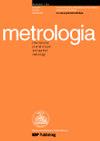Traceable characterisation of fibre-coupled single-photon detectors
IF 2.4
3区 工程技术
Q2 INSTRUMENTS & INSTRUMENTATION
引用次数: 0
Abstract
The detection of single photons plays an essential role in advancing single-photon science and technologies. Yet, within the visible/near-infrared spectral region, accurate fibre-based optical power measurements at the few-photon level are not yet well-established. In this study, we report on a fibre-based setup, enabling traceable optical power measurements at the few-photon level in this spectral region. The setup was used to calibrate the detection efficiency (DE) of four single-photon avalanche diode (SPAD) detectors. The relative standard uncertainties on the mean DE values obtained from repeat fibre-to-detector couplings ranged from 0.67% to 0.81% (光纤耦合单光子探测器的可追溯特性分析
单光子探测在推动单光子科学和技术发展方面发挥着至关重要的作用。然而,在可见光/近红外光谱区,基于光纤的少光子级精确光功率测量尚未得到充分证实。在本研究中,我们报告了一种基于光纤的装置,该装置能够在该光谱区域进行可追溯的少光子级光功率测量。该装置用于校准四个单光子雪崩二极管(SPAD)探测器的探测效率(DE)。重复光纤到探测器耦合得到的平均 DE 值的相对标准不确定性在 0.67% 到 0.81% 之间(k = 2)。然而,DE 值的相对标准偏差从 1.38% 到 3.20%(k = 2)不等,这对这些设备的计量以及要求高精度和可重复性的应用提出了挑战。我们通过使用聚焦自由空间光束对探测器光纤连接器端口的响应进行空间映射,研究了这些变化的来源,从而估算出探测器的空间不均匀性。此外,我们还为自由空间配置中的光纤耦合 SPAD 实现了一种新的校准方法,从而能够将基于光纤的设置与国家物理实验室利用单个 SPAD 建立的自由空间设施进行直接比较。最后,我们还研究了其他耦合方法,除了光纤到探测器的直接耦合外,还测试了不同光纤到光纤连接器的可重复性:我们使用单模和多模光纤对三家制造商生产的 SPAD 进行了测试。
本文章由计算机程序翻译,如有差异,请以英文原文为准。
求助全文
约1分钟内获得全文
求助全文
来源期刊

Metrologia
工程技术-物理:应用
CiteScore
2.80
自引率
25.00%
发文量
137
审稿时长
12 months
期刊介绍:
Published 6 times per year, Metrologia covers the fundamentals of measurements, particularly those dealing with the seven base units of the International System of Units (metre, kilogram, second, ampere, kelvin, candela, mole) or proposals to replace them.
The journal also publishes papers that contribute to the solution of difficult measurement problems and improve the accuracy of derived units and constants that are of fundamental importance to physics.
In addition to regular papers, the journal publishes review articles, issues devoted to single topics of timely interest and occasional conference proceedings. Letters to the Editor and Short Communications (generally three pages or less) are also considered.
 求助内容:
求助内容: 应助结果提醒方式:
应助结果提醒方式:


